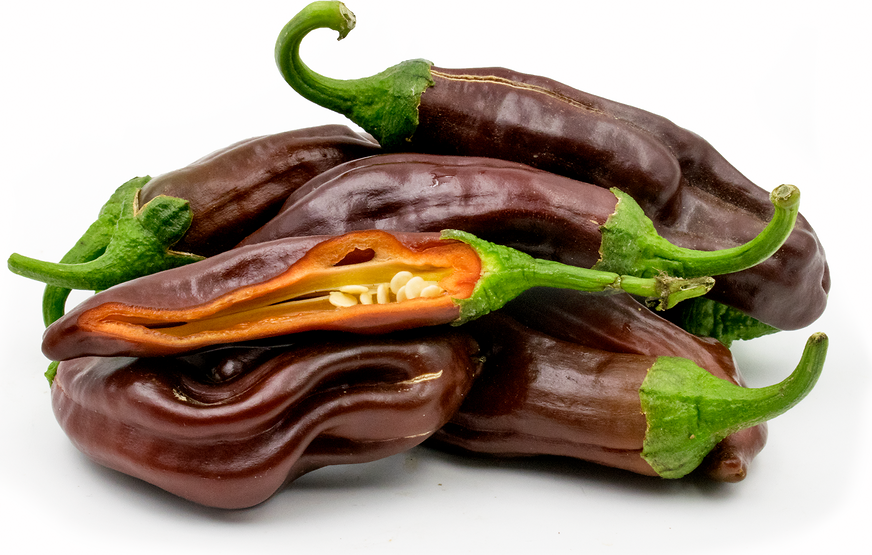


Ethiopian Brown Chile Peppers
Estimated Inventory, lb : 0
Description/Taste
Ethiopian Brown chile peppers are elongated and slender pods, averaging 10 to 15 centimeters in length, and have a conical shape that tapers to a point on the non-stem end. The pods may be slightly curved or straight and have some deep folds and wrinkles, giving the pepper a wrinkled appearance. The skin is glossy and smooth, ripening from green to a dark, chocolate brown-red when mature. Underneath the tough skin, the flesh is medium-thick, red-orange, and crisp, encasing a central cavity filled with membranes and round and flat, cream-colored seeds. Ethiopian Brown chile peppers are juicy and have a rich, smoky flavor with a tangy fruitiness. The peppers also have a moderate heat that builds gradually, hitting the back of the throat first and then slowly spreads to the rest of the mouth.
Seasons/Availability
Ethiopian Brown chile peppers are available in the late summer through fall.
Current Facts
Ethiopian Brown chile peppers, botanically classified as Capsicum annuum, are a rare African variety that belongs to the Solanaceae or nightshade family. Also known as the Berbere pepper and the Ethiopian Berbere, Ethiopian Brown chile peppers have a moderate to hot level of spice, ranging 30,000 to 50,000 SHU on the Scoville scale. Ethiopian Brown chile peppers are not common outside of northeastern Africa and are more likely to be found globally in dried form in specialty markets or ground into the famous spice blend known as Berbere.
Nutritional Value
Ethiopian Brown chile peppers are an excellent source of vitamin C, a good source of vitamins B6 and A, and contain some iron, copper, and potassium. The peppers also contain capsaicin, which is a chemical compound that causes the brain to feel heat or spice and has been shown to provide anti-inflammatory properties.
Applications
Ethiopian Brown chile peppers can be used in both raw or cooked applications such as roasting, sautéing, and baking. When fresh, the peppers can be chopped and tossed into salads or blended into sauces, marinades, or dips. Ethiopian Brown chile peppers can also be sliced and stirred into soups and stews, cooked with roasts, mixed into beans, or lightly stir-fried with vegetables. In addition to cooked applications, the peppers can be dried, ground into a powder, and used as a dry rub for grilled meats or blended into barbeque sauces. Ethiopian Brown chile peppers pair well with chickpeas, sweet corn, avocado, eggplant, tomatoes, mushrooms, oregano, cumin, coriander, turmeric, quinoa, eggs, and meats such as poultry, pork, lamb, or beef. The fresh peppers will keep up to one week when loosely stored whole and unwashed in a plastic bag in the refrigerator.
Ethnic/Cultural Info
Ethiopian Brown chile peppers are most well-known for their use in berbere, which is a traditional spice blend that has been used in Ethiopian cuisine for hundreds of years. Made with dried and ground Ethiopian Brown chile peppers, fenugreek, salt, pepper, allspice, cardamom, and ginger, the spice blend offers a spicy, earthy flavor used for meats, soups, stews, and lentil dishes. Each family in Ethiopia has its own creative blend, which is passed down from generation to generation, and this blend is what gives the food a unique, vibrant flavor that is difficult to replicate. Berbere can be used in its dried, powdered state, or it can be mixed with water into a paste. Both the powder and the paste can be incorporated into a sauce and consumed alongside injera, a traditional spongy flatbread, or it can be mixed with garlic and wine to make a dip known as awaze. Berbere is also an essential ingredient in doro wot, which is a chicken stew that is prized as Ethiopia’s national dish.
Geography/History
Ethiopian Brown chile peppers are native to Ethiopia and Eritrea, located along the Red Sea on the eastern coast of Africa. These chile peppers are descendants of the original chiles that were first brought to northeastern Africa from Central and South America by Portuguese explorers sometime during the 15th and 16th centuries. Today Ethiopian Brown chile peppers are not commonly found outside of Ethiopia, but some seeds are available for home gardening through global, online sellers. The peppers are also sometimes grown through small, specialty farms and are sold at farmer’s markets in Europe and the United States.




